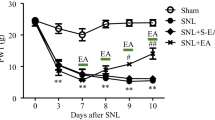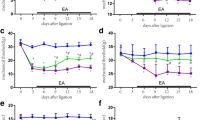Abstract
Objective
To study the effects of electroacupuncture (EA) in chronic constrictive injury (CCI) rat model and the expression of N-methyl-D-aspartate receptor type 2B (NR2B) in ipsilateral spinal dorsal horn in rats to explore the analgesic mechanisms of EA.
Methods
According to the random number table, totally 180 rats were evenly divided into a sham group, a CCI group, and an EA group. CCI model was conducted with four 4–0 chromic gut ligatures loosely ligated around the left sciatic nerve 1 cm above the trifurcation. Rats in the EA group received 2 Hz EA therapy bilaterally at acupoints of Zusanli (ST 36) and Sanyinjiao (SP 6) once daily (30 min/d) for 30 days after surgery. Paw withdrawal thresholds (PWTs) were measured on 0 (baseline), 1, 3, 7, 15, 30 days after surgery. Rats were sacrificed on 0, 1, 3, 7, 15 and 30 days after surgery, and the L4–5 segments of spinal cord were removed to detect the expression of NR2B by immunohistochemistry and quantitative polymerase chain reaction.
Results
PWTs in the CCI group were significantly lower than the sham group at Day 1–30 after surgery, and reached its lowest at Day 1 (P<0.01). After EA treatment, the PWTs recovered rapidly and were significantly higher than those in the CCI group on 3, 7, 15 and 30 days after surgery (P<0.01). The numbers of NR2B-immunoreactive cells of the CCI group significantly increased after CCI surgery compared with the sham group (P<0.01). Compared with the CCI group, stimulation of EA markedly decreased the numbers of NR2B-immunoreactive cells at Day 3, 7, 15 and 30 (P<0.05). In the sham group, NR2B mRNA was expressed at a low level. It increased after CCI surgery, which increased rapidly at Day 7 (P<0.01) and reached its peak value at Day 15 (P<0.01). After EA stimulation, relative quantity of NR2B mRNA expression was less than that in the CCI group at Day 15 and 30 (P<0.05).
Conclusions
Low frequency of EA had antinociceptive effect in CCI rat model. The analgesic effects of EA might be through the inhibition of NR2B.
Similar content being viewed by others
References
Goldberg DS, McGee SJ. Pain as a global public health priority. BMC Public Health 2011;11:770–774.
Bonakdar RA. Integrative pain management. Med Clin North AM 2017;101:987–1004.
Chen S, Wang S, Rong P, Wang J, Qiao L, Feng X, et al. Acupuncture for visceral pain: neural substrates and potential mechanisms. Evid Based Complement Alternat Med 2014;2014:609594.
Harris RE, Zubieta JK, Scott DJ, Napadow V, Gracely RH, Clauw DJ. Traditional Chinese acupuncture and placebo (sham) acupuncture are differentiated by their effects on μ–opioid receptors (MORs). Neuroimage 2009;47:1077–1085.
Liao HY, Hsieh CL, Huang CP, Lin YW. Electroacupuncture attenuates induction of inflammatory pain by regulating opioid and adenosine pathways in mice. Sci Rep 2017;7:42531–42539.
Li A, Wang Y, Xin J, Lao L, Ren K, Berman BM, et al. Electroacupuncture suppresses hyperalgesia and spinal Fos expression by activating the descending inhibitory system. Brain Res 2007;1186:171–179.
Yan X, Jiang E, Gao M, Weng HR. Endogenous activation of presynaptic NMDA receptors enhances glutamate release from the primary afferents in the spinal dorsal horn in a rat model of neuropathic pain. J Physiol 2012;591:2001–2019.
Zhao WS, Shi H, Fang JF, Fang JQ. The value of Wenjing Tongbi Decoction on pain threshold of sciatica and expression of NR2B in spinal cord. J Zhejiang Chin Med Univ (Chin) 2014;38:17–21.
Chiang CY, Liu SA, Sheu ML, Chen FC, Chen CJ, Su HL, et al. Feasibility of human amniotic fluid derived stem cells in alleviation of neuropathic pain in chronic constrictive injury nerve model. PLoS One 2016;11:e0159482.
Fang JQ, Du JY, Liang Y, Fang JF. Intervention of electroacupuncture on spinal p38 MAPK/ATF–2/VR–1 pathway in treating inflammatory pain induced by CFA in rats. Mol Pain 2013;9:13.
Senna–Fernandes V, França DL, de Souza D, Santos KC, Sousa RS, Manoel CV, et al. Acupuncture at "Zusanli" (ST.36) and "Sanyinjiao" (SP.6) points on the gastrointestinal tract: a study of the bioavailability of (99m) tc–sodium pertechnetate in rats. Evid Based Complement Alternat Med 2011;2011:823941.
Frank D, Kuhn C, Brors B, Hanselmann C, Lü dde M, Katus HA, et al. Gene expression pattern in biomechanically stretched cardiomyocytes: evidence for a stretch–specific gene program. Hypertension 2008;51:309–318.
Vulfsons S, Bar N, Eisenberg E. Back pain with leg pain. Curr Pain Headache Rep 2017;21:32–41.
Bauer BA, Tilburt JC, Sood A, Li GX, Wang SH. Complementary and alternative therapies for chronic pain. Chin J Integr Med 2016;22:403–411.
Konstantinou K, Dunn KM, Ogollah R, Lewis M, van der Windt D, Hay EM. Prognosis of sciatica and back–related leg pain in primary care: the ATLAS cohort. Spine J 2018;18:1030–1040.
Ro LS, Chang KH. Neuropathic pain: mechanisms and treatments. Chang Gung Med J 2005;28:597–605.
Rohini Kuner. Central mechanisms of pathological pain. Nature Med 2010;16:1258–1266.
Carvajal FJ, Mattison HA, Cerpa W. Role of NMDA receptor–mediated glutamatergic signaling in chronic and acute neuropathologies. Neur Plast 2016;2016:2701526.
Liu H, Zhang Y, Qi D, Li W. Downregulation of the spinal NMDA receptor NR2B subunit during electro–acupuncture relief of chronic visceral hyperalgesia. J Physiol Sc 2017;67:197–206.
Ishiko N, Yamamoto T, Murayama N, Hanamori T. MElectroacupuncture: current strength–duration relationship for initiation of hypesthesia in man. Neurosci Lett 1978;8:273–276.
He XF, Wei JJ, Shou SY, Fang JQ, Jiang YL. Effects of electroacupuncture at 2 and 100 Hz on rat type 2 diabetic neuropathic pain and hyperalgesia–related protein expression in the dorsal root ganglion. J Zhejiang Univ Sci B 2017;18:239–248.
Liang Y, Du JY, Qiu YJ, Fang JF, Liu J, Fang JQ. Electroacupuncture attenuates spinal nerve ligation–induced microglial activation mediated by p38 mitogen–activated protein kinase. Chin J Integr Med 2016;22:704–713.
Shao XM, Shen Z, Sun J, Fang F, Fang JF, Wu YY, et al. Strong manual acupuncture stimulation of "Huantiao" (GB 30) reduces pain–induced anxiety and p–ERK in the anterior cingulate cortex in a rat model of neuropathic pain. Evid Based Complement Alternat Med 2015;2015:235491.
Jiang YL, Yin XH, Shen YF, He XF, Fang JQ. Low frequency electroacupuncture alleviated spinal nerve ligation induced mechanical allodynia by inhibiting TRPV1 upregulation in ipsilateral undamaged dorsal root ganglia in rats. Evid Based Complement Alternat Med 2013;2013:170910.
Kim JH, Chung JY, Kwon YK, Kim KJ, Yang CH, Hahm DH, et al. Acupuncture reduces alcohol withdrawal syndrome and c–Fos expression in rat brain. Am J Chin Med 2005;33:887–896.
Acknowledgements
All authors thank LOU Ji-yu (Zhejiang University, China), FANG Jian-qiao, FANG Fang and FANG Jun-fan (The 3rd Clinical Medical College, Zhejiang Chinese Medical University, China) for technical assistance. The authors thank Dr. FAN Zhang for English proofreading.
Author information
Authors and Affiliations
Corresponding author
Additional information
Supported by the Zhejiang Provincial Natural Science Foundation of China (No. LY14H270007)
Rights and permissions
About this article
Cite this article
Zhao, Ws., Jiang, Zn., Shi, H. et al. Low-Frequency Electroacupuncture Alleviates Chronic Constrictive Injury-Induced Mechanical Allodynia by Inhibiting NR2B Upregulation in Ipsilateral Spinal Dorsal Horn in Rats. Chin. J. Integr. Med. 25, 462–467 (2019). https://doi.org/10.1007/s11655-018-3057-4
Accepted:
Published:
Issue Date:
DOI: https://doi.org/10.1007/s11655-018-3057-4




